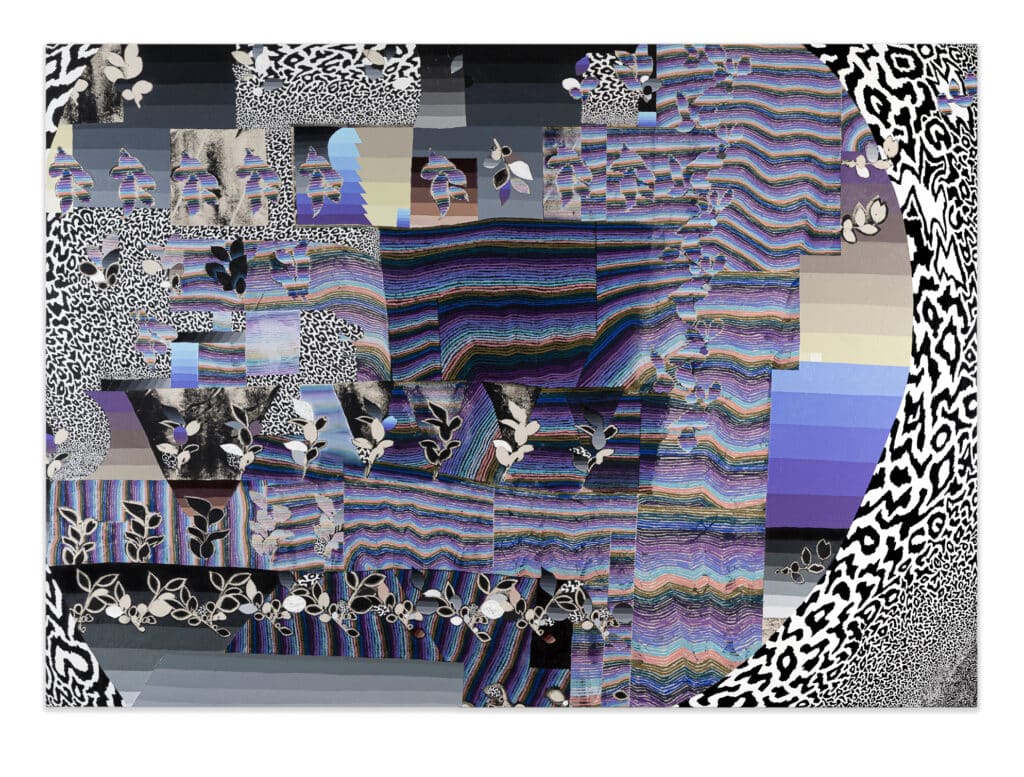“Discordant Harmony”: Paintings by Will Hutnick at Geary Contemporary

Chronogram | March 11, 2024
By Taliesin Thomas
Above:
Photopsia, 2024
Acrylic, colored pencil, ink, sand and wax pastel on canvas
60 in x 84 in
The mighty composer Leonard Bernstein once commented that: “A work of art does not answer questions, it provokes them.” Given the highly lyrical quality of Will Hutnick’s solo show “Satellite,” through April 7 at Geary Contemporary in Millerton, Bernstein’s statement echoes throughout this sublime exhibition of recent work. Hutnick’s spinning satellite of artistic questioning is a melodically inspired visual thrill, propelling us out of orbit and back again with his purposefully discordant painterly harmonies.
Like most things these days, my introduction to Hutnick’s work was digital. Seeing his art in person was not only a real-time high, but it was also an entirely more-than-meets-the-eye experience. Hutnick’s layering of paint is both intensely exploratory and quasi mysterious—where certain areas of the canvas feel calculatingly perfect, other areas magically unravel. His compositions are spacey, layered worlds, and the backgrounds appear stratified and burned, producing a slightly agitated effect. Familiar objects such as spheres, clouds, leaves, graphically lovely flowers, and dense half rainbows are reconfigured to serve the overall retro look. Hutnick’s command of these elements is coordinated flow piqued by moments of rugged rupture.
There is also a stitched, jagged gesture that takes place across all Hutnick’s paintings, and some areas of his canvases seem to be sown with a paint-as-threadwork technique. Works such as Late in the Day to Start Asking Now (2024) are wondrously uniform yet also strangely dimensional, and flatter areas are up-ended by realms of magnitude. His careful layering of colors and combinations of shapes yields a distinct visual language, one that reflects his affinity for the rhythmic. In his larger work Photopsia (2024), for example, moments of familiar patterning are proportional with disorientation and quasi hallucinatory pockets of design.
Hutnick’s canvases also capture something bewitching from 1980s analog visual culture and works such as Spooky Action #1 (2024) and Spooky Action #2 (2024) embody the cybernated allure and fantastic atmosphere as seen in movies like Blade Runner and Tron. His hazy horizons and floating world vibe conjure alternative realities, and we willingly flow into this megacosm.
I had the pleasure of sitting with Hutnick to discuss his work during the lively opening in February, and he spoke of his community activities (he is the director of artistic programming at the Wassaic Project in Amenia), his musical background (he plays cello), and his interest in certain “atonal qualities and purposeful disruption” that plays out in his work (all while wrangling his adorable toddler with his admiring husband at his side).
There is a distinct sound-quality to his art, where painterly energies both overlap and collide, mix and re-mix in a symphonic flow. Hutnick also shared with me his candid ideas about “queerness contextualized” in relation to his art as he referenced aspects of contemporary queer literature that inspire him. Hutnick is asking all the right questions of himself as he navigates these interconnected areas of his practice: “how much representational information can I put into a work…and still toggle that nebulous line between abstraction and representation? How much information is enough?” he wrote in our follow-up correspondence. Either way, we willingly jump aboard Hutnick’s “Satellite” on a sensational journey into his pondering cosmos. With Hutnick, questions are not answered—they are brilliantly dispersed across an abundant vista of his infinite investigation.